When it comes to extinct reptiles, none get more attention than the dinosaurs. And why not? They are fascinating creatures. But there was another group of creatures sharing the dinosaur’s world. Ruling the skies, they were every bit as fantastic as the land-lubbing saurians. These were the pterosaurs, or flying reptiles. You have probably seen them depicted soaring in the background of pictures, movies, and documentaries while dinosaurs are the stars of the show, hogging all the attention.
The views expressed in this article reflect those of the author, and not necessarily those of New Creation.
But pterosaurs deserve awareness too. And when they do get a little attention, they are usually visualized in the way scientists used to portray them back in the mid-20th century. So much has changed since then! New fossil discoveries from all over the world (including Antarctica) have transformed our understanding of these creatures.
As we will soon discover, they were every bit as amazing, diverse, and mysterious as the dinosaurs.
What is a Pterosaur?
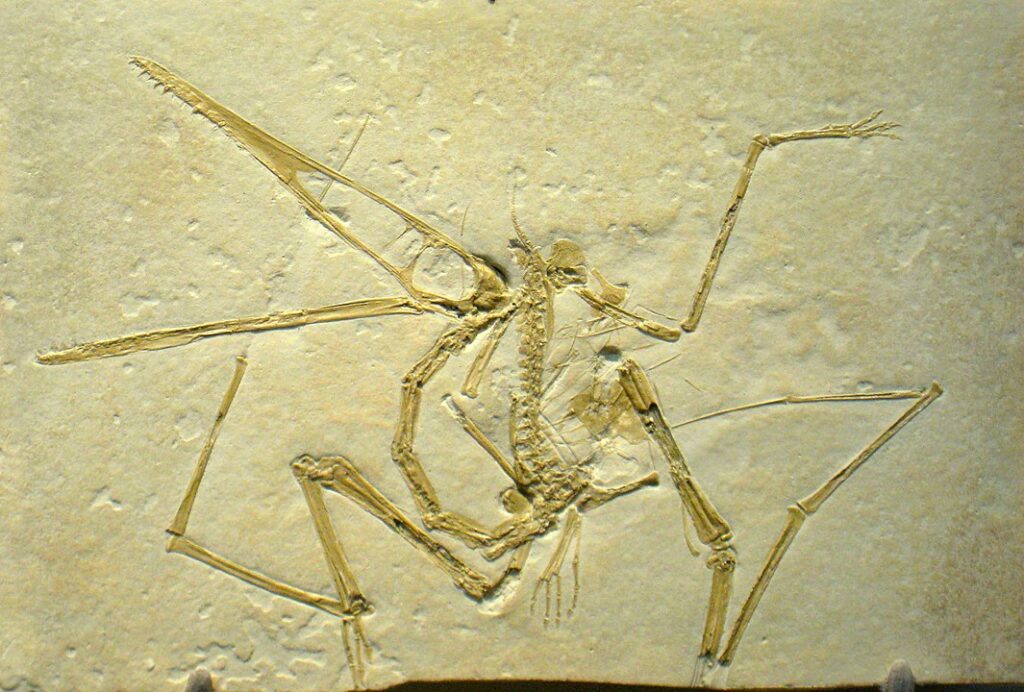
We know pterosaurs existed because we have discovered their fossils buried in the rocks of the earth. Pterosauria, meaning “wing lizard,” is the official name of the group.1 The first scientists to lay eyes on their preserved remains were mystified. They had had a hard time trying to figure out what type of animal they were. But as time went on, they began to realize just what set pterosaurs apart from other creatures.
They’re Not Dinosaurs

Crocodiles, dinosaurs, and pterosaurs belong to a group of reptiles called archosaurs. However, a special trait distinguishes dinosaurs from other archosaurs. This trait is a special hole in their hip socket, called the perforated acetabulum. No crocodile or pterosaur has this feature, meaning that they are not true dinosaurs. However, pterosaurs are still some of the most similar animals to dinosaurs.
They’re Not Birds or Bats
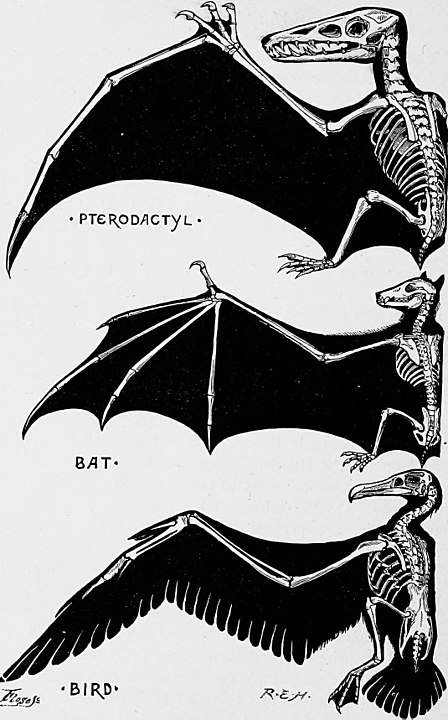
The types of bones that makeup the wing of a bat, bird, or pterosaur are the same, but they are shaped and arranged in different ways for their specific needs. A bird’s wing is composed of long feathers streaming off from its hand and arm. A bat’s wing is made up of a special membrane stretched across elongated fingers of its hand. On the other hand (pun intended), well-preserved fossils of pterosaurs show us that they had a three-layered membrane running from shoulder to leg, supported by an elongated finger. The membrane was infused with blood vessels, fibrous cords, and muscles.
They’re Flying Reptiles…But Don’t Call Them “Pterodactyls”!
![By ДиБгд at Russian Wikipedia - Originally from ru.wikipedia; description page is/was [1]., Public Domain, https://commons.wikimedia.org/w/index.php?curid=51956434 | By Matthew P. Martyniuk - File:Pterodactylus_holotype_fly_mmartyniuk.png, CC BY-SA 4.0, https://commons.wikimedia.org/w/index.php?curid=122385226](https://newcreation.blog/wp-content/uploads/2022/12/Add-a-heading-1024x819.png)
Pterosaurs are best described as flying reptiles. You have probably also heard them collectively referred to as “pterodactyls.” Originally, the name “pterodactyl” belonged to a species of European pterosaur, that scientists now describe as Pterodactylus. Even though the general public uses “pterodactyl” as a catch-all name for any pterosaur, scientists frown on this because of the confusion to which it leads. Today, “pterodactyl” is no longer used in the scientific community.
Two main types of pterosaurs existed. The long-tailed pterosaurs, called rhamphorhynchoids, and short-tailed pterosaurs, called pterodactyloids. Between them, pterosaurs exhibited incredible diversity, with more than 200 different species known from the fossil record.
What Did Pterosaurs Look Like?
Pterosaurs were every bit as diverse as the dinosaurs. But perhaps the most recognizable was Pteranodon. This creature had a wingspan of up to 20 feet long and a long crest on the back of its head. If you have seen a pterosaur in a movie it was very likely a Pteranodon. But what many media depictions of this creature get wrong is that the males and females looked very different from each other. Males were larger and had a longer crest while females were smaller with a very tiny crest.
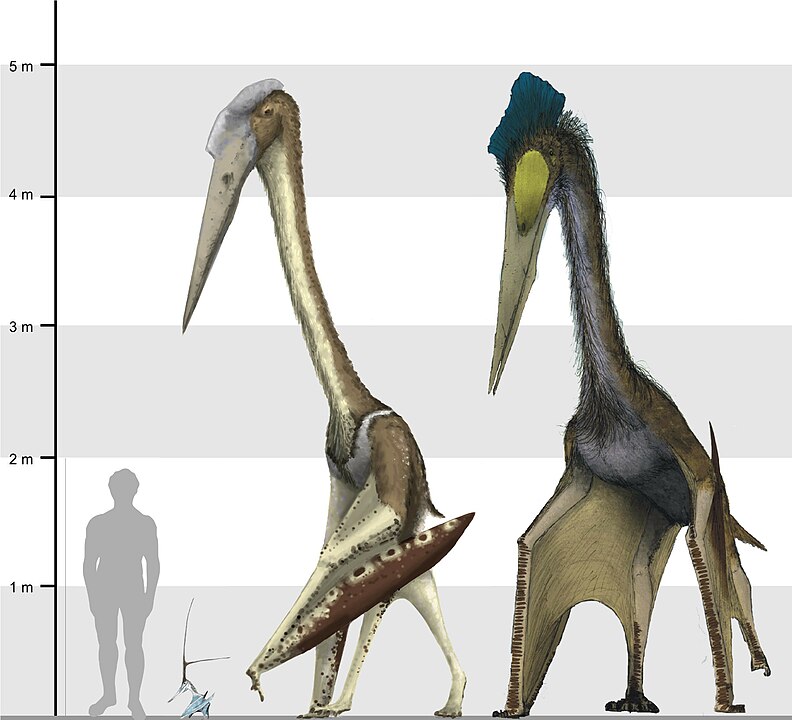
But Pteranodon was not the only pterosaur out there, nor was it the largest. One of the goliaths taking this title is Quetzalcoatlus. Discovered in Texas, this creature stood almost as tall as a giraffe. It had a wingspan of over 30 feet, making it the size of a small airplane. On the other end of the scale was Anurognathus which was only the size of a bat or sparrow. Many pterosaurs had elaborate crests on their heads. One of the most unusual crests belonged to Tupandactylus (named after the Tupi god of thunder). Shaped a bit like a sail, this crest consisted mostly of keratin, the same material making up your hair and nails.
Fuzzy Pterosaurs?
Even though pterosaurs were reptiles, well-preserved specimens show that most, if not all, did not possess scaly skin. Instead, they had a unique hairy-like pelt of filaments called pycnofibers.2,3 Paleontologists once hotly debated the exact nature of these pycnofibers, but most now understand them to be feathers. These feathers were clearly not for flight, but would have helped the animals stay warm (like downy feathers on a chick). This implies that pterosaurs had a very active metabolism, more like mammals and birds than modern reptiles.
On the Origin of Pterosaurs
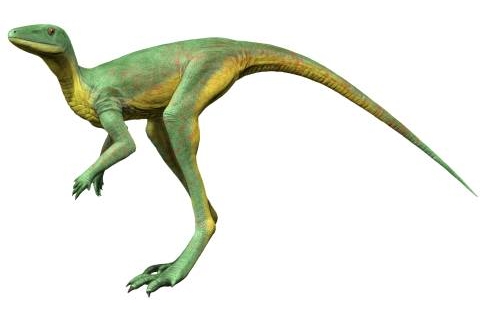
Evolutionary paleontologists believe that pterosaurs share common ancestry with both dinosaurs and crocodiles. They often debate which evolutionary trajectory pterosaur ancestors would have taken.
The difficulty with any proposed hypotheses so far is the lack of fossil evidence for these alleged pterosaur ancestors.4 In one geological moment we have ground-dwelling reptiles from which pterosaurs are supposed to have evolved. In the next geological moment, the first pterosaurs appear in the fossil record not only perfectly suited for flight, but already quite diverse. Researchers have identified at least four different main types of pterosaurs in these fossil deposits.5,6
Given just how distinct pterosaurs are from other organisms, young-earth paleontologists do not think it likely that they evolved from land-walking archosaurs. The Bible records that God created various kinds of winged “birds” on Day 5 of Creation Week (Genesis 1:20-23). The Hebrew word for “bird” in this passage is “oph.” Leviticus 11:19 lists the bat as an oph, as it does the locust in Leviticus 11:22. This word clearly includes much more than our modern word “bird.” A better translation is “flying creature.” Since pterosaurs are flying creatures, they would have been created on Day 5 as well.
Pterosaur Kinds
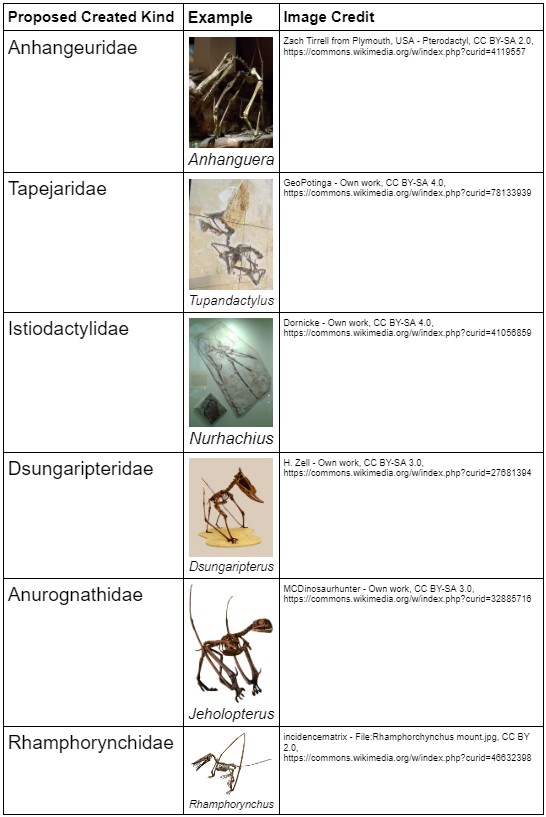
Great diversity is on display among pterosaurs. Did God create all pterosaur species seen throughout the fossil record during Creation Week? According to Genesis 1:21, God created the flying creatures according to their kinds. These “created kinds” each gave rise to a diversity of species after the events of Creation Week and after the Fall of Man.
The field of study devoted to identifying these created kinds is baraminology. Previous work has been done on humans, as well as a variety of animal groups, including horses, whales, and dinosaurs. What would the results of pterosaurs show?
Work on pterosaurs is ongoing, but research done so far suggests that Pterosauria consists of several created kinds.7,8,9
Pterosaur Behavior
Flying with Pterosaurs
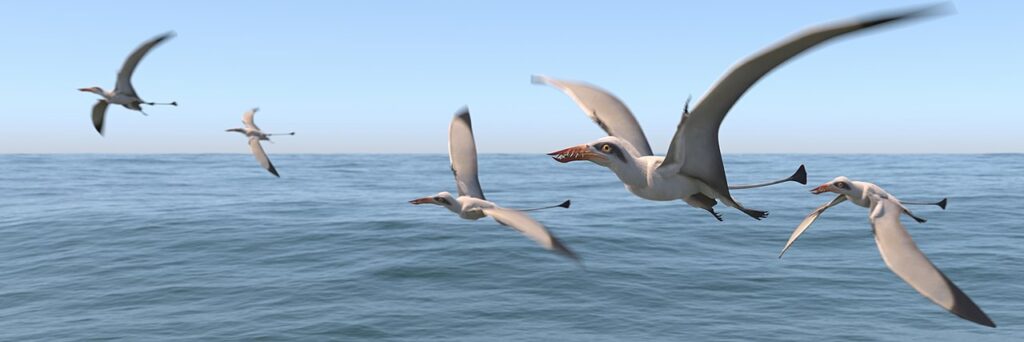
Just how does a reptile take to the air? For a long time, researchers thought pterosaurs were mediocre gliders. Old dinosaur books often showed them climbing to the top of a cliff and then leaping off, like a living, primitive hang glider.10
However, new discoveries and recent research shows that pterosaurs were masters of the air.11 God modified several features from His conceptual blueprint of reptiles when He made pterosaurs. For one thing, He designed the bones of their skull and skeleton as partially hollow and filled them with air sacs. A network of bony struts within the bones strengthened them from the inside. This design made them incredibly lightweight for their size. Even Hatzegopteryx, at the size of a small airplane, only weighed 480 pounds or so.12
But how did such massive animals take flight? Most birds get into the air by leaping upward with their legs and flapping their wings. Analysis of pterosaur skeletons suggests that their legs would not be capable of such a feat. However, they possessed heavily muscled upper abdomen and arms. Scientists believe that pterosaurs sprung into the air using their muscular arms before flapping to gain lift. This method is called pole-vaulting and is similar to that employed by modern vampire bats.13
Once airborne, even the largest pterosaurs were masters of the sky. Though they were more than capable of flying under their own power, it would have been more energy-efficient for them to glide. Vultures and eagles do this today. They often ride over warm updrafts of air that lift them higher and higher into the sky. Some researchers think that the larger pterosaurs may have been able to travel up to 80 mph for 7-10 days at altitudes of 15,000 feet!14
Did All Pterosaurs Eat Fish?
People used to picture pterosaurs as fish-eating hang gliders. In addition to believing they could only glide, we also once thought they were very clumsy on the ground. When hunting, they would soar low over the ocean’s surface and snag fish with their beaks.
But pterosaurs were so much more diverse than this! Fossil footprints show that these animals were more than capable of walking comfortably on the ground.15 They walked on all fours, similar to how vampire bats do in modern times. Another difference between pterosaurs and dinosaurs is that true dinosaurs walked on their toes. But pterosaurs were plantigrade, meaning they walked on their whole foot, like we do.
Studies of pterosaur beaks show they were not designed for skimming across the water with their beaks.16 Rather, fish-eating pterosaurs like Pteranodon would plunge into the water, swimming after fish and catching them in their jaws. They would return to the surface and take to the air. We know Pteranodon ate fish because researchers have found specimens with fish preserved in their stomachs.
What Else Did Pterosaurs Eat?
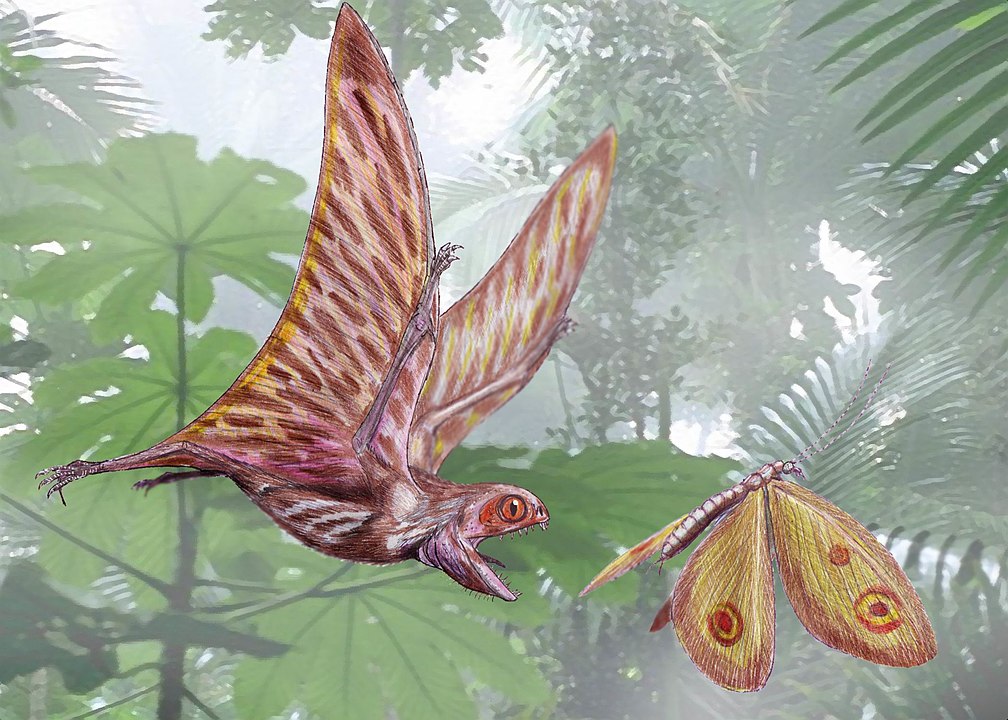
But not all pterosaurs ate fish.17 Studies of its fossils suggest that while Dimorphodon could fly, it obtained most of its food by foraging on the ground for small vertebrates. The wing design of the tiny Anurognathus made it maneuverable enough in the air to catch flying insects. The curved claws of Tapejara are like those of tree-climbing animals today, and their beaks were much like those of parrots. This has led scientists to suggest that they primarily ate fruit.18 The jaws of Pterodaustro were lined with hundreds of bristle-like teeth. It may have used them to stream plankton, algae, and other tiny organisms from the water, sort of like what flamingos do.19
Some pterosaurs were even apex predators. Hatzegopteryx was the pterosaur version of a Tyrannosaurus rex. Researchers think it hunted primarily on the ground.20 With strong neck muscles and a beak longer than a full-grown man, it may have behaved much like a giant stork, scoping its domain for smaller animals, including dinosaurs!
Pterosaur Eggs
Like most other reptiles, fossils show that pterosaurs laid eggs. This highlights another difference between dinosaurs and pterosaurs: most dinosaurs laid hard-shelled eggs, but pterosaurs laid soft-shelled and leathery eggs, like a lizard’s.21 Scientists have even found groups of male and female pterosaurs preserved alongside their nests, which indicates that at least some species laid eggs in colonies, much like seabirds do today.22
Are There Any Pterosaurs Alive Today?
Some people think that pterosaurs have not disappeared, but are still alive in the remote corners of the world. One alleged example is the Kongamato, which some claim dwells in the East African bush. Another is the Ropen of Papua New Guinea, a nocturnal, bioluminescent creature with a crested head, a long tail, and a toothy beak.
Unfortunately, the only evidence that such creatures exist are these alleged sightings. No one has ever found physical clues left behind by such creatures. Given that the search for these “undiscovered” pterosaurs has gone on for decades with little success, the most likely conclusion is that they do not exist.
Areas of Further Research
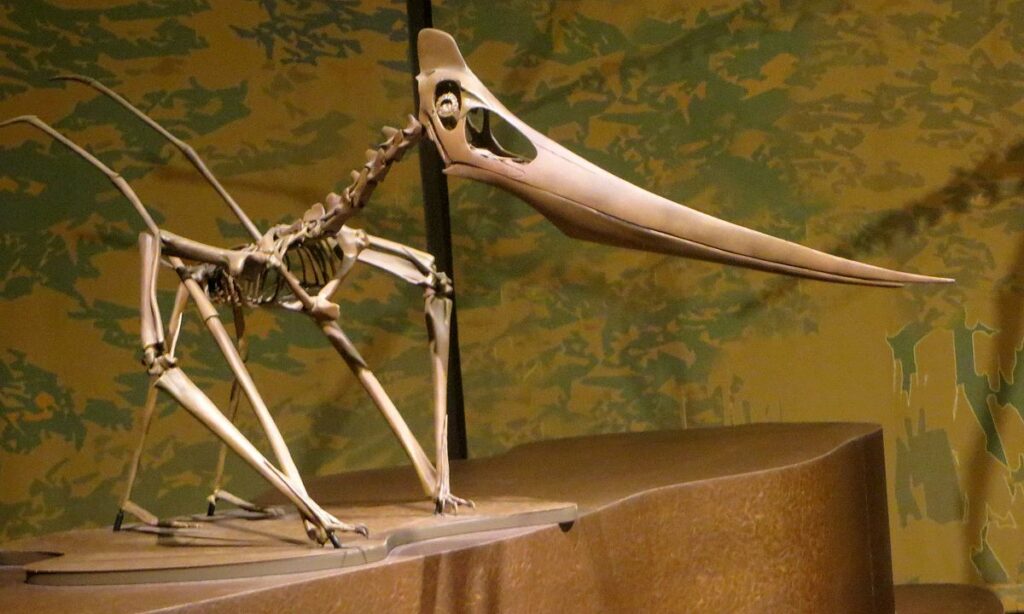
As biblical creationists, there are many fruitful fields of investigation for us to spend our resources on.
Fossil Record of Pterosaurs
Pterosaurs, no matter the species, are found exclusively beside other lifeforms excavated from Mesozoic rock layers. Researchers have never found them beside modern mammal groups, including humans. While conventional science believes the fossil record represents various evolutionary stages, the consensus among young-earth paleontologists differs. They think the fossil record represents the order in which the Flood buried different organisms. Most modern mammal groups do not show up in the Flood-deposited rock layers themselves, but only in the more recent post-Flood deposits on top of them. This explains why we don’t find modern mammals buried with pterosaurs.
While birds do appear in rock layers alongside pterosaurs, it is the pterosaurs that appear in the fossil record first. Even more so, there is a general order in which fossils of pterosaurs appear. For example, the rhamphorynchoids appear before pterodactyloids do. How are these observations to be explained? While more data-driven research is needed to appropriately answer these questions, several factors can be hypothesized.23 One is that the fossil record of pterosaurs represents the burial of animals along a habitat gradient. In other words, some pterosaurs living in one habitat suffered the onslaught and burial of the floodwaters first, followed by pterosaurs and birds living in other habitats. Flight ability might also have played a role, especially if pterosaurs buried in upper layers could stay aloft for longer periods of time than those in lower layers.
Pterosaur Extinction
The last pterosaurs in the fossil record disappear alongside the dinosaurs and a large number of other animals. According to the conventional paradigm, these pterosaurs died out some 66 million years ago when an asteroid hit the Earth in the Gulf of Mexico.
Most young-earth paleontologists, however, think that this asteroid impact occurred during the Flood. God brought at least two of every kind of air-breathing flying creature to Noah for preservation on the Ark. This would have included what may have been 17 to 20 kinds of pterosaurs. Because of this, they would have survived the Flood and the K-Pg asteroid impact. They do not appear to have done well after the Flood. Young-earth paleontologists are eagerly studying the rock record, looking for clues that might tell them why this was the case.
Conclusion
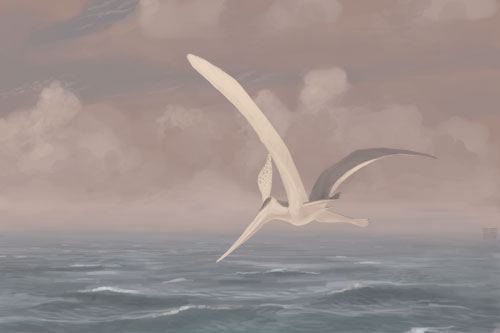
Pterosaurs once ruled the skies in a wide variety of forms and habitats. They exhibited about as many behaviors as there were species. These flighted creatures deserve every bit as much attention as the land-living dinosaurs. Mysteries about pterosaurs abound, and while we still strive to answer unanswered questions about them, we marvel at yet another example of the beauty and diversity with which God filled His creation.
Footnotes
- And no, despite their name, they are not lizards either. Lizards belong to a different group of reptiles, distinct from archosaurs, called Squamata, which also contains snakes. ↩︎
- McLain, M. “Did Pterodactyls Have Feathers, and Does It Matter?” TJTMI Issue 2, Spring 2023, pp. 5–28 ↩︎
- Yang, Z., Jiang, B., McNamara, M.E. et al. 2019. “Pterosaur integumentary structures with complex feather-like branching.” Nat Ecol Evol 3, 24–30. ↩︎
- Examples of alleged pterosaur ancestors include Sclermochlus and Lagerpeton. Neither was capable of flight or even had adaptations for gliding. See the following papers for more discussion:
a) Bennett, S.C. 2020. “Reassessment of the Triassic archosauriform Scleromochlus taylori: neither runner nor biped, but hopper.” PeerJ. 8: e8418.
b) Ezcurra, Martín D.; Nesbitt, Sterling J.; Bronzati, Mario; Dalla Vecchia, Fabio Marco; Agnolin, Federico L.; Benson, Roger B. J.; Brissón Egli, Federico; Cabreira, Sergio F.; Evers, Serjoscha W.; Gentil, Adriel R.; Irmis, Randall B.; Martinelli, Agustín G.; Novas, Fernando E.; Roberto da Silva, Lúcio; Smith, Nathan D.; Stocker, Michelle R.; Turner, Alan H.; Langer, Max C. 2020. “Enigmatic dinosaur precursors bridge the gap to the origin of Pterosauria.” Nature. 588 (7838): 445–449. ↩︎ - Brian Andres, James Clark, Xing Xu. 2014. “The Earliest Pterodactyloid and the Origin of the Group.”Current Biology, Volume 24, Issue 9, Pg. 1011-1016. ↩︎
- Britt, B.B., Dalla Vecchia, F.M., Chure, D.J., Engelmann, G.F., Whiting, M.F., and Scheetz, R.D. 2018. “Caelestiventus hanseni gen. et sp. nov. extends the desert-dwelling pterosaur record back 65 million years.” Nature Ecology & Evolution 2:1386-1392. ↩︎
- Clausen, C. McLain, M.A. 2021. “Interpreting Confusing Results in Pterosaur Baraminology Research.” Journal of Creation Theology and Science Series B: Life Sciences 11:2. ↩︎
- McLain, M.A. 2021. “Baraminology of Non-Pterodactyloid Pterosaurs Reveals Evidence of Multiple Created Kinds.” Journal of Creation Theology and Science Series B: Life Sciences 11:5-6. ↩︎
- Let’s Talk Creation. (2022, September 13). Episode 15: Pterosaurs, Cave Formation, and Windows in Heaven. YouTube. https://youtu.be/uzMptVMaTaA?t=763. Accessed March 25, 2022 [Video]. Website. https://URLLet’s Talk Creation. Youtube. 2022. [online] [Accessed 26 March 2022]. ↩︎
- Pterosaurs very rarely had books devoted to them back in those days. They were usually portrayed as the supporting cast to the ever-popular dinosaurs. ↩︎
- Witton, Mark P., and Michael B. Habib. 2010. “On the size and flight diversity of giant pterosaurs, the use of birds as pterosaur analogues and comments on pterosaur flightlessness.” PloS one 5, no. 11 (2010): e13982. ↩︎
- Naish, D.; Witton, M.P. 2017. “Neck biomechanics indicate that giant Transylvanian azhdarchid pterosaurs were short-necked arch predators.” PeerJ. 5: e2908. ↩︎
- Naish; Witton, 2017, PeerJ. 5: e2908. (Footnote 12) ↩︎
- Frazier, R. 2010. “Peerless pterosaur could fly long-distance for days”. Morning Edition. NPR. Retrieved March 25, 2022. ↩︎
- Hwang, Koo-Geun, M. I. N. Huh, Martin G. Lockley, David M. Unwin, and Joanna L. Wright. 2002. “New pterosaur tracks (Pteraichnidae) from the Late Cretaceous Uhangri formation, southwestern Korea.” Geological Magazine 139, no. 4: 421-435. ↩︎
- Humphries, S., Bonser, R.H.C., Witton, M.P. and Martill, D.M. 2007. “Did pterosaurs feed by skimming? Physical modelling and anatomical evaluation of an unusual feeding method. PLoS Biology, 5(8), p.e204. ↩︎
- Humphries, Bonser, Witton and Martill, 207, PLoS Biology, 5(8), p.e204. (Footnote 15) ↩︎
- Wu, W. H., Zhou, C. F., & Andres, B. 2017. “The toothless pterosaur Jidapterus edentus (Pterodactyloidea: Azhdarchoidea) from the Early Cretaceous Jehol Biota and its paleoecological implications.” PloS one, 12(9), e0185486. ↩︎
- Humphries, Bonser, Witton and Martill, 207, PLoS Biology, 5(8), p.e204. (Footnote 15) ↩︎
- Frazier, R. 2010. Morning Edition. NPR. (Footnote 13) ↩︎
- Ji, Q., Ji, SA., Cheng, YN. et al. 2004. “Pterosaur egg with a leathery shell.” Nature 432, 572. ↩︎
- Wang, Xiaolin. 2014. “Sexually Dimorphic Tridimensionally Preserved Pterosaurs and Their Eggs from China”. Current Biology. 24 (12): 1323–30. ↩︎
- McLain, M. 2014. “Pterosaurs of the Triassic.” Geoscience Research Institute. Retrieved May 19, 2022. ↩︎


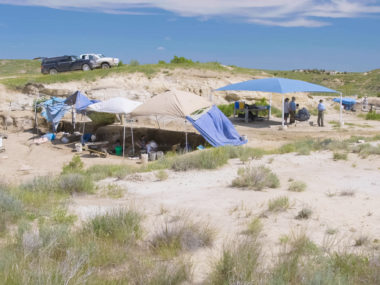

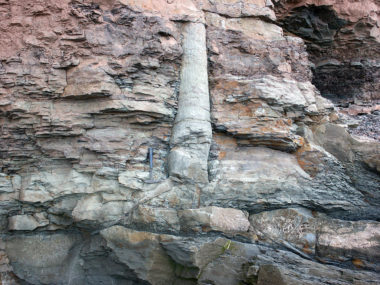


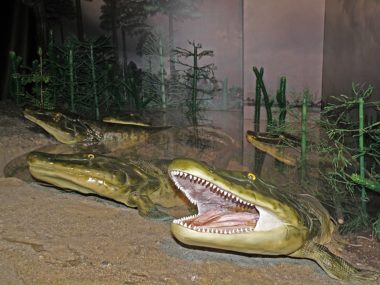




I love pterosaurs, they are my favorite non-dinosaur reptiles.
They were very beautiful creatures, which God made along with the birds, bats and insects on day 5 of creation.
They have a Mosaic of characteristics that make them unique, which distinguishes them from reptiles such as dinosaurs, crocodiles and lizards.
Curiously, one thing I would have added, in the 1800’s pterosaurs were portrayed with ears and hair, but today and for a long time paleontologists have known that those first artistic reconstructions (along with that of dinosaurs and other extinct creatures ) were wrong.
I understand that ancient explorers and historians, such as Flavius Josephus, Gaius Solinus, Herodotus, spoke of small flying reptiles in ancient Egypt and Arabia and described their predators, the ibis, stopping their invasion of Egypt.
God bless you Cristian Ryann
I deny there were dinosaurs. I doubt these creatures were reptiles. I don’t think god created reptiles but thats a worthless human invention connecting unrelated creatures by trivial like traits. A good summery article on these creatures,. i don’t have any guess yet what they are. the feathers is a clue. it might be possible they are al;so just a diversity of birds and due to great size have some extra traits that so called reptiles have. Creationiism should seek to deny they are any relationship to so called dinosaurs or reptiles I thimnk.
Beautiful article. I might add that most likely – at leat according to the „Hovind-Theory“ – there was a canpy of ice above the skies before the flood, which would have sustained higher air pressure in the atmosphere. This canopy would have been shattered by the comet that triggered the Flood, and the now lowered air pressure is not sufficient at least for very big winged creatures to fly. This, along with othee grave changes in earth‘s environment, like for example a lower oxygen-level because of severely reduced vegetation, or higher radiation levels because of the missing canopy, is the most likely reason for the extinction of the bigger pterosaurs. There might be some smaller ones still around, thiugh, as you have mentioned.
Christian Greetings,
Andrew